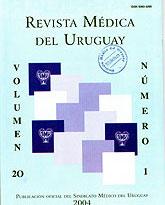Primer aislamiento en Uruguay de Escherichia coli productora de toxina Shiga del serotipo O157:H7 en una niña con síndrome urémico hemolítico
Palabras clave:
SÍNDROME HEMOLÍTICO-URÉMICO, INFECCIONES POR ESCHERICHIA COLI, ESCHERICHIA COLI O157, TOXINA SHIGA
Resumen
En mayo de 2002 se aisló por primera vez en Uruguay Escherichia coli O157:H7, productora de toxina Shiga a partir del coprocultivo de una niña de 16 meses procedente de Melo, con diagnóstico de síndrome urémico hemolítico. La cepa, productora de toxinas Shiga tipo 2 y tipo 2 variante humana a, era genéticamente distinta de las cepas circulantes en Argentina.
Citas
1) Gianantonio CA, Vitacco M, Mendilaharzu F, Gallo GE, Sojo ET. The hemolytic-uremic syndrome. Nephron 1973; 11(2):174-92.
2) Chinen I, Tanaro JD, Miliwebsky E, Lound LH, Chillemi G, Ledri S, et al. Isolation and characterization of Escherichia coli O157:H7 from retail meats in Argentina. J Food Prot 2001; 64(9):1346-51.
3) Miliwebsky ES, Balbi L, Gómez D, Wainsztein R, Cueto Rúa M, Roldán C, et al. Síndrome urémico hemolítico en niños de Argentina: asociación con la infección por Escherichia coli productor de toxina Shiga. Bioq Patol Clin 1999; 63:113-21.
4) Paton JC, Paton AW. Pathogenesis and diagnosis of Shiga toxin-producing Escherichia coli infections. Clin Microbiol Rev 1998; 11(3):450-79.
5) Elliott EJ, Robins-Browne RM, O'Loughlin EV, Bennett-Wood V, Bourke J, Henning P, et al. Nationwide study of haemolytic uraemic syndrome: clinical, microbiological, and epidemiological features. Arch Dis Child 2001; 85(2):125-31.
6) Elder RO, Keen JE, Siragusa GR, Barkocy-Gallagher GA, Koohmaraie M, Laegreid WW. Correlation of enterohemorrhagic Escherichia coli O157 prevalence in feces, hides and carcasses of beef cattle during processing. Proc Natl Acad Sci USA 2000; 97(7):2999-3003.
7) Olsen SJ, Miller G, Breuer T, Kennedy M, Higgins C, Walford J, et al. A waterborne outbreak of Escherichia coli O157:H7 infections and hemolytic uremic syndrome: implications for rural water systems. Emerg Infect Dis 2002; 8(4):370-5.
8) Crump JA, Sulka AC, Langer AJ, Schaben C, Crielly AS, Gage R, et al. An outbreak of Escherichia coli O157:H7 infections among visitors to a dairy farm. N Engl J Med 2002; 347(8):555-60.
2) Chinen I, Tanaro JD, Miliwebsky E, Lound LH, Chillemi G, Ledri S, et al. Isolation and characterization of Escherichia coli O157:H7 from retail meats in Argentina. J Food Prot 2001; 64(9):1346-51.
3) Miliwebsky ES, Balbi L, Gómez D, Wainsztein R, Cueto Rúa M, Roldán C, et al. Síndrome urémico hemolítico en niños de Argentina: asociación con la infección por Escherichia coli productor de toxina Shiga. Bioq Patol Clin 1999; 63:113-21.
4) Paton JC, Paton AW. Pathogenesis and diagnosis of Shiga toxin-producing Escherichia coli infections. Clin Microbiol Rev 1998; 11(3):450-79.
5) Elliott EJ, Robins-Browne RM, O'Loughlin EV, Bennett-Wood V, Bourke J, Henning P, et al. Nationwide study of haemolytic uraemic syndrome: clinical, microbiological, and epidemiological features. Arch Dis Child 2001; 85(2):125-31.
6) Elder RO, Keen JE, Siragusa GR, Barkocy-Gallagher GA, Koohmaraie M, Laegreid WW. Correlation of enterohemorrhagic Escherichia coli O157 prevalence in feces, hides and carcasses of beef cattle during processing. Proc Natl Acad Sci USA 2000; 97(7):2999-3003.
7) Olsen SJ, Miller G, Breuer T, Kennedy M, Higgins C, Walford J, et al. A waterborne outbreak of Escherichia coli O157:H7 infections and hemolytic uremic syndrome: implications for rural water systems. Emerg Infect Dis 2002; 8(4):370-5.
8) Crump JA, Sulka AC, Langer AJ, Schaben C, Crielly AS, Gage R, et al. An outbreak of Escherichia coli O157:H7 infections among visitors to a dairy farm. N Engl J Med 2002; 347(8):555-60.
Publicado
2004-03-31
Cómo citar
1.
Gadea M del P, Varela G, Bernadá M, Sirok A, Mota MI, Sabelli R, Grotiuz G, Schelotto F, Chinen I, Chillemi G, Rivas M. Primer aislamiento en Uruguay de Escherichia coli productora de toxina Shiga del serotipo O157:H7 en una niña con síndrome urémico hemolítico. Rev. Méd. Urug. [Internet]. 31 de marzo de 2004 [citado 7 de junio de 2025];20(1):79-1. Disponible en: http://www2.rmu.org.uy/ojsrmu311/index.php/rmu/article/view/933
Sección
Casos Clínicos














